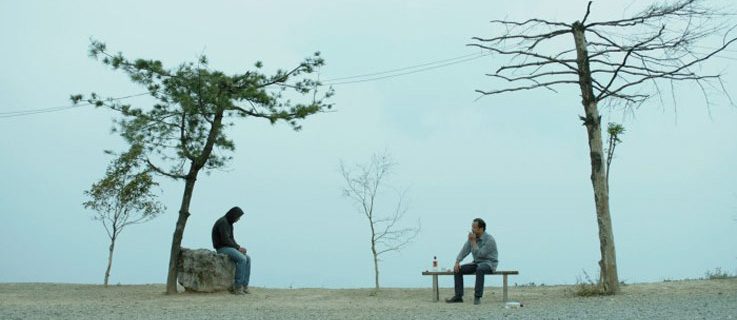A migrant worker returns to his hometown, a godforsaken region strewn with ruined buildings and forlorn-looking streets, which feels more like a ghost town than home.
Visually stunning and narratively intriguing, Heng Yang’s Ghost in the Mountains is a beautiful meditative process. The film is set against the backdrop of mystic mountains, sometimes sunny and sometimes misty. Lao Liu, a middle-aged man who has worked in big cities for decades, suddenly returns to his hometown. Here, in a place now populated by the elderly and adolescents, he chain-smokes and binge-drinks with an old buddy, visits the tomb of a deceased friend and meets up with his childhood sweetheart who is about to marry a wealthy elderly man in the south. The settings feel at once realistic yet otherworldly; we accompany Lao Lius as he wanders among deserted ruins, alongside the picturesque lake, inside hermitic caves deep in the mountains, and to local restaurant-bars piled high with empty beer bottles. Using predominantly medium to long shots, the camera avoids getting too close to faces and objects, creating instead a theatrical stage upon which characters appear contrapuntally. The camera pans very calmly and at times panoramically to reveal the off-screen space. Although some of the film’s themes, such as crime, violence, adultery or death, might invite a faster pace of filming, Ghost in the Mountains does not want to rush at all. It composes each frame in a picturesque and painterly way, and allows us to enter a meditative, trance-like state.
Another thing that evokes a sense of meditation is the film’s circular and parallel narrative structure. Whereas Lao Liu and his friends could represent the future for the young delinquents in the village, are these teenagers their past or perhaps their re-embodiment and reincarnation? With much intentional ambiguity and fluidity, the film merely provokes thoughts and poses questions without attempting to provide answers.
There are some very zen moments that I particularly like, such as when we see two chairs face to face in front of a leafless trees, or when two characters are depicted standing on a veranda that defines the space with its various geometric lines. With cleverly orchestrated scenes such as these, Ghost in the Mountains beautifully illustrates a popular Chinese saying: “lift something heavy with the same ease as you lift something light”. It is uncomfortable to see how regional wealth divide is an everyday reality or to watch gratuitous crimes committed, yet there is also a great deal of lightness in the film, such as in the way absurd moments are made humorous and ruins are reclaimed by nature.
